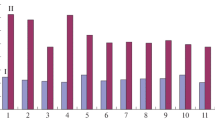Abstract
The time length required for the adaptation of AFP-27 hybridoma cells to high osmotic pressure and the effect of a gradual increase of osmotic pressure on monoclonal antibody production were investigated. When the cells were subjected to an increase of osmotic pressure from 300 mOsmol kg-1 to 366 mOsmol kg- 1, the intracellular content of osmoprotective free amino acids reached a maximum level 6 h after the osmotic pressure was increased to 366 mOsmol kg-1. The same time period of 6 h incubation at 366 mOsmol kg-1 was required to obtain a high growth rate of AFP-27 cells at 440 mOsmol kg-1 when the cells were subjected to a two-step increase of osmotic pressure from 300 mOsmol kg-1 to 366 mOsmol kg-1 and then to 440 mOsmol kg-1. The time length for the physiological adaptation of the cells to 366 mOsmol kg-1 was consequently estimated to be 6 h. Osmotic pressure during batch cultivation was gradually increased from 300 mOsmol kg-1 to 400 mOsmol kg-1 with an adaptation time of at least 6 h. The specific growth rates following a gradual increase of osmotic pressure were higher than those at a constant osmotic pressure of 400 mOsmol kg-1, while the specific monoclonal antibody production rate increased with the increase in the mean osmotic pressure. As a result, the cells grown under a gradual increase of osmotic pressure produced higher amounts of monoclonal antibodies than did those grown under constant osmotic pressure.
Similar content being viewed by others
References
Banik G and Health A (1995) Hybridoma growth and antibody production as a function of cell density and specific growth rate in perfusion culture. Biotechnol Bioeng 48: 289-300.
Berg TM, Øyaas K and Levine DW (1990) Growth and antibody production of hybridoma cells exposed to hyperosmotic stress. In: Murakami H (ed) Trends in Animal Cell Culture Technology, Kodansha, Tokyo, pp. 93-97.
Chua FHF, Yap MGS and Oh SKW (1994) Hyper-stimulation of monoclonal antibody production by high osmolarity stress in eRDF medium. J Biotech 37: 365-375.
Deaton LE, Hilbish TJ and Koeln RK (1984) Protein as a source of amino nitrogen during hyperosmotic volume regulation in the mussel Mytilus edulis. Physiol Zool 57: 609-619.
Frame KK and Hu W (1990) The loss of antibody productivity in continuous culture of hybridoma cells. Biotechnol Bioeng 35: 469-476.
Lee GM and Park SY (1995) Enhanced specific antibody productivity og hybridomas resulting from hyperosmotic stress in cell line specific. Biotechnol Lett 17: 145-150.
Lin JQ, Takagi M, Qu IB, Gao PJ and Yoshida T (1997) Metabolic flux change in hybridoma cells under high ormotic pressure. To be submitted.
Oh SKW, Vig P, Chua F, Teo WK and Yap MGS (1993) Substantial overproduction of antibodies by applying osmotic pressure and butyrate. Biotechnol Bioeng 42: 601-610.
Og SKW, Chua FKF and Choo ABH (1995) Intracellular responses of productive hybridomas subjected to high osmotic pressure. Biotechnol Bioeng 46: 525-535.
Øyaas K, Ellingsen TE, Dyrset N and Levine DW (1994a) Utilization of osmoprotective compounds by hybridoma cells exposed to hyperosmotic stress, Biotechnol Bioeng 43: 77-89.
Øyaas K, Ellingsen TE, Dyrset N and Levine DW (1994b) Hyperosmotic hybridoma cell cultures: Increased monoclonal antibody production with addition of glycine betaine. Biotechnol Bioeng 44: 991-998.
Ozturk SS and Palsson BO (1991) Effect of medium osmolarity on hybridoma growth, metabolism, and antibody production. Biotechnol Bioeng 37: 989-993.
Reddy S, Bauer KD and Miller WM (1992) Determination of antibody content in live versus dead hybridoma cells: Analysis of antibody production in osmotically stressed cultures. Biotechnol Bioeng 40: 947-964.
Reitzer LJ, Wise BM and Kennell D (1979) Evidence that flutamine not sugar is the major energy source for cultured HeLa cells. J Biol Chem 254: 2669-2676.
Shotwell MA, Kilberg MS and Oxender DL (1983) The regulation of neutral amino acid transport in mammalian cells. Biochimica et Biophysica Acta 737: 267-284.
Takagi M, Ohara K and Yoshida T (1995) Effect of hydrostatic pressure on hybridoma cell metabolism. J Ferm Bioeng 80: 619-621.
Yancey PH, Clark ME, Hand SC, Bowlus RD and Somero GN (1982) Living with water stress: Evolution of osmolyte systems. Science 217: 1214-1222.
Author information
Authors and Affiliations
Corresponding author
Rights and permissions
About this article
Cite this article
Lin, J., Takagi, M., Qu, Y. et al. Enhanced monoclonal antibody production by gradual increase of osmotic pressure. Cytotechnology 29, 27–33 (1999). https://doi.org/10.1023/A:1008016806599
Issue Date:
DOI: https://doi.org/10.1023/A:1008016806599




